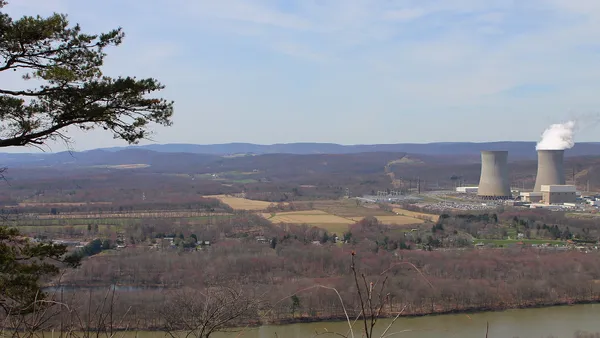Natural gas producers are only just beginning to access an entirely new market, a potential boon to their bottom lines. But if those energy supplies are sent into higher-priced global markets, will there be an impact on consumers in the United States?
The country is poised to become a net exporter of natural gas by 2018, and soon after could be a world leader in global liquefied natural gas trade. That is a remarkable turnaround, considering a decade ago the United States was importing LNG to the tune of about 9 billion cubic feet per day (Bcf/d).
Before last year, there were no LNG exports out of the lower-48 states. Now there is one terminal — Cheniere Energy's Sabine Pass — and four more projects are under construction.
Buoyed by hydraulic fracturing production techniques and shale gas discoveries, LNG exports represent an entirely new market for gas producers who have found themselves awash in cheap supply. Sabine Pass has exported to two dozen countries and sent out almost 100 cargos in the last six months.
Do higher exports mean higher prices?
LNG has not typically been a political issue, but expanded exports would fit alongside President Trump's vow to make the United States "energy dominant." At the least, the U.S. Energy Information Administration expects the country to be a net exporter of energy overall, by 2020. But some analysts and market participants are now sounding the alarm, worried that the rapid development of an export market will leave consumers at home stuck with higher prices as more American supplies are sent abroad.
Andrew Weissman, senior counsel at the Washington, D.C., law firm Pillsbury, said that within three to four years, the rapid growth of LNG exports could inject significant uncertainty into the marketplace.
"I think it's pretty clear that at some point down the road, unless we take action to manage price volatility much more effectively than were are doing so far, at some point there is a substantial risk we will see some of the most severe price volatility we've seen in natural gas," Weissman told Utility Dive. "And of course it would spill over into electricity markets."
For some perspective, 1 billion cubic feet of gas can power about 24,000 homes for a year.
To supercool natural gas into a liquid state, some gas delivered to the LNG terminal is used to fuel the process and the remainder is exported. While gas exports are measured in metric tons, the Sabine Pass terminal is currently receiving about 2 Bcf/d of gas according to tracking firm Celsius Energy.
The other four LNG export terminals are expected to be online by 2021, and combined with Sabine Pass, the United States would have export potential from the lower-48 of 9.2 Bcf/d.
"The first round of LNG projects is going to ramp up quickly," Deepa Poduval, senior managing director of oil and gas in Black & Veatch's consulting business, told Utility Dive. But Black & Veatch has a more moderate take on the potential impact.
"It's difficult to anticipate a situation where we're actually supply constrained," said Poduval.
Make no mistake, the export potential represents a lot of natural gas. The electric power sector is expected to burn about 25 Bcf/d next year, and total U.S. consumption will be about 75 Bcf/d according to EIA.
According to Weissman, in the next three to four years, the United States could be exporting 10% to 15% of its natural gas production.
"We are now at the early stages of an enormous ramp-up," he said. "There are things which can be done to manage the price volatility … but if we don't take some pretty major actions, we will see times when there are enormous swings in demand, larger than we've ever seen before."
Do greater exports help or hurt US economics?
Industrial consumers are sounding the alarm as well, potentially hit twice should prices rise because of exports: their costs go up while they also give up competitive advantage.
In April, the Industrial Energy Consumers of America (IECA) trade group sent a letter to Secretary of Energy Rick Perry, cautioning against rapidly expanding natural gas exports. "The continued growth of LNG exports does not maximize American jobs or economic growth," the group wrote.
A study prepared for IECA by Charles River Associates found keeping natural gas at home, rather than exporting, led to greater job growth. Comparing the economic benefit of using gas in manufacturing versus exporting, the study concluded using the gas domestically generated eight times more jobs, and twice the direct value added per year.
In 2015, a study performed for the Department of Energy spelled out the potential impacts in no uncertain terms.
"As exports increase, the spread between U.S. domestic prices and international benchmarks narrows. In every case, greater LNG exports raise domestic prices and lower prices internationally," the report concluded.
Performed by Oxford Economics, Leonardo Technologies and Rice University, the study considered LNG exports between 12 Bcf/d and 20 Bcf/d.
"Low‐price natural gas is contributing to a revitalization of the industrial base in the United States," the authors wrote. "The economic benefit at the upstream level is apparent ... Farther downstream, there are also ongoing and planned expansions in the petrochemical and manufacturing sectors, a development fueled by low‐
cost natural gas."
According to IECA, low-cost gas was a driver behind 264 chemical industry-related projects, representing over $161 billion in new investment, announced since 2010.
Industrial consumers warned that the federal government has so far conditionally approved LNG exports totaling more than 90% of domestic demand last year. Export permits to Free Trade Agreement and non-Free Trade Agreement countries are needed for a project to be approved.
"This is a stunningly significant amount of natural gas exports, which raises enormous concerns of future price risk upon trillions of dollars of existing and future U.S. manufacturing facilities," ICEA told Secretary Perry.
But that's not an opinion shared by all. A 2012 study by NERA Economic Consulting concluded there was a limit to what price the international markets would pay, and domestic consumers would likely remain protected.
"The global market limits how high U.S. natural gas prices can rise under pressure of LNG exports because importers will not purchase U.S. exports if U.S. wellhead price rises above the cost of competing supplies," NERA concluded. "In particular, the U.S. natural gas price does not become linked to oil prices in any of the cases
examined."
NERA looked at several possible export outcomes, and concluded "across all these scenarios, the U.S. was projected to gain net economic benefits from allowing LNG exports."
Prices could also go down
Volatility goes both ways, Weissman said. It's possible a global supply glut could send prices plummeting.
"Prices will go in both directions," he said. "I'm definitely not predicting we will see sky-high prices for years, but we will see the effects of large swings in demand."
Asked about the possible impact on domestic gas prices, Cheniere Energy declined to comment for this story. But in its Aug. 8 earnings call with analysts, Chief Commercial Officer Anatol Feygin said the company "continues to find buyers globally at a premium to European gas markets."
Deliveries to Europe remain less than 15% of overall deliveries from Sabine Pass, with cargos seeking out the highest-priced markets often heading to Latin America, Asia or the Middle East. But LNG supply is not just increasing out of the United States. Projects are ramping up in Australia, said Feygin, and 15 million tonnes of incremental supply has hit the market through June.
While demand remains robust, the wealth of supply means buyers are avoiding longer-term contracts.
"Market conditions continue to be challenging for long-term deals as buyers have slowed the pace of contracting," Feygin said. "However, we remain actively engaged with buyers interested in term contracts."
According to Weissman, within a decade, the domestic price of natural gas could be moving between extremes of $1/Mcf and $10/Mcf. "Uncertainties in global LNG markets are at least four to five times greater," he said. "What happens in the real world, most often, producers can't adjust fast enough."
There is something the natural gas industry could do to dampen price volatility, Weissman said — build more storage.
"We've got plenty of gas in the ground. I'm a very strong believer that we have at least a couple of hundred years of low-cost supply in the ground," said Weissman. "But we have very limited storage capacity ... really a tiny reserve capacity."
The United States has about 4,400 Bcf of storage capacity and in the past has used up to 4,000 Bcf to meet winter demand. Weissman said the country could need up to 6,000 Bcf of storage capacity to effectively mitigate price swings generated by LNG exports.
"That's too short a time [to develop additional storage facilities], unless the federal government decided tomorrow," he said.
But Black & Veatch's Poduval said some of these fears are ignoring just how well producers have matched demand in the past. "Because there are abundant shale resources, we expect the overall impact on domestic natural gas prices to be relatively small. Certainly whatever effects there are will be outweighed."
Looking globally at "the magnitude of the need for energy in the developing world, you're going to need renewables and gas to meet it," said Poduval.























